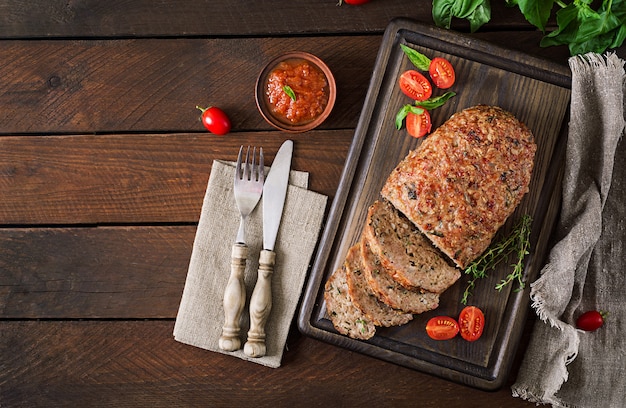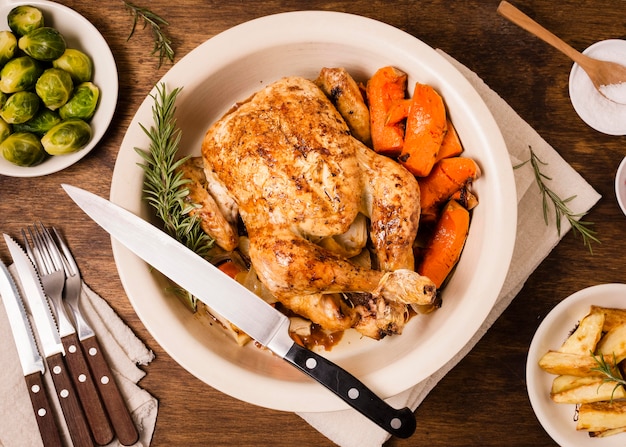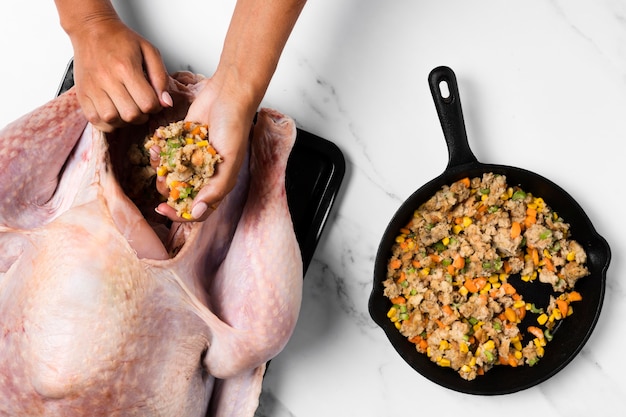Part 1: The Turkey Breast – Getting Started

Choosing Your Turkey Breast
First things first, you need to pick a good turkey breast. I always go for a boneless, skin-on option. It's easier to cook and, let me tell you, the skin makes a world of difference to the flavour! When selecting your turkey breast, make sure it's firm to the touch, without any discolouration. A good butcher will be able to point you towards the best cuts and give you a rough estimate of the cooking time based on the weight.Prepping Your Turkey Breast
Okay, your turkey breast is all set – time to give it a bit of a makeover.First, pat it dry thoroughly with kitchen paper. This is crucial for achieving a nice, crispy skin. Next, I like to rub it all over with a generous amount of olive oil and salt. If you're feeling adventurous, add some freshly ground black pepper, garlic powder, or even a pinch of paprika. The key is to season generously and let those flavours infuse the meat!
Part 2: Roasting the Turkey Breast

The Oven – Getting It Hot
Now, your turkey breast is prepped and ready to go. Time to get that oven cranking! I recommend preheating your oven to 350°F (175°C) for about 15 minutes. This ensures that the oven is nice and hot when the turkey goes in, promoting even cooking.Choosing the Right Pan
You need a pan that's big enough to hold your turkey breast comfortably, and one that allows for good air circulation around it. A roasting pan with a rack is ideal. The rack lifts the turkey breast off the bottom of the pan, allowing for even browning and preventing it from steaming.Time to Roast!
Place your prepped turkey breast on the roasting rack, breast side up. Here's where things get interesting.A lot of recipes suggest roasting your turkey breast for around 1 hour and 45 minutes, but I've found that's not always enough time to get it cooked through. So, my advice is to use a meat thermometer to ensure your turkey is cooked to perfection. This little tool is a lifesaver!
internal temperature – The Key to Success
Your turkey breast is cooked when the internal temperature reaches 165°F (74°C) in the thickest part of the breast. This temperature ensures that any harmful bacteria are eliminated, and your turkey is safe to eat. The meat thermometer is your best friend here – don't be afraid to use it!Part 3: Resting the Turkey Breast

Give It a Break!
Once your turkey breast is cooked through, take it out of the oven and let it rest for at least 15 minutes. This crucial step allows the juices to redistribute throughout the meat, resulting in a much more tender and succulent turkey. It's worth the wait!Part 4: Carving the Turkey Breast
Time for the Show!
After the resting period, you can finally carve your beautiful turkey breast. I like to use a sharp carving knife for this job. A good knife will make the process much easier and less messy.Slicing it Right
Start by cutting along the bone, then slice across the grain of the meat. This ensures you get nice, even slices that are easy to chew and digest.Part 5: Serving the Turkey Breast
It's Time to Feast!
Now, the moment you've been waiting for: serving up your delicious roasted turkey breast. I like to serve it with traditional sides like mashed potatoes, stuffing, and gravy. But feel free to get creative and go for something different – maybe a cranberry sauce, roasted vegetables, or even a salad.Part 6: turkey breast leftovers – What to Do?
Don't Waste a Bit!
Leftovers? That's fantastic! Don't let any of that delicious turkey go to waste.Here are some of my favourite ways to use turkey leftovers:
- turkey sandwiches – a classic!
- turkey soup – warming and comforting.
- turkey salad – a great lunch option.
- turkey pot pie – a hearty and satisfying meal.
- Turkey enchiladas – a delicious and unexpected twist!
Part 7: Tips and Tricks
Keeping Your Turkey Breast Moist
It's essential to keep your turkey breast moist while it's roasting.One trick is to tent it with foil for the first part of the cooking time. This helps to trap in the moisture and prevents the turkey from drying out. I usually tent it for about half the total cooking time, then remove the foil for the last part to allow the skin to crisp up.
Basting for Added Flavor
Another tip is to baste your turkey breast every 30 minutes. This involves pouring the pan juices over the turkey, which helps to keep it moist and adds flavour. You can use a spoon or a baster for this.Using a Meat Thermometer
I can't stress this enough – use a meat thermometer! It's the best way to ensure your turkey breast is cooked through and safe to eat. It's a small investment that can make a big difference in the quality of your turkey.Using a Brine for Added Flavor and Juiciness
Brining is a great way to add flavour and moisture to your turkey breast. It involves soaking the breast in a salt-water solution for several hours before roasting. This helps to break down the muscle fibers and allows the turkey to absorb the brine, resulting in a more flavorful and juicy turkey. You can also add other flavourings to the brine, such as herbs, spices, or citrus.Part 8: Turkey Breast Cooking Time Chart
A Quick Reference
Here's a handy table to help you estimate the cooking time for your turkey breast based on its weight:| Weight (lbs) | Cooking Time (hours) |
|---|---|
| 4 - 6 | 1.5 - 2 |
| 7 - 9 | 2 - 2.5 |
| 10 - 12 | 2.5 - 3 |
Part 9: FAQs
1. What if my turkey breast is frozen?
If your turkey breast is frozen, you'll need to defrost it in the fridge for 24 hours per 5 pounds. I find it's best to defrost the breast in the fridge on a large plate to catch any drips. It's also a good idea to allow an extra 30 minutes to an hour of cooking time for a frozen turkey breast.2. Can I cook my turkey breast in a slow cooker?
You certainly can! I've tried this, and it's a great option for those who want a hands-off approach. Just cook your turkey breast on low for 6-8 hours, or on high for 3-4 hours. Be sure to use a slow cooker that is large enough to accommodate the turkey breast without overcrowding.3. Can I add stuffing to my turkey breast?
You can, but I recommend cooking it separately in a casserole dish. Stuffing inside the turkey breast can take longer to cook and could increase the risk of foodborne illness. Also, stuffing inside the turkey can make it more difficult to achieve an even internal temperature.4. How do I know if my turkey breast is cooked through?
The best way to tell if your turkey breast is cooked through is to use a meat thermometer. It should register 165°F (74°C) in the thickest part of the breast. If you don't have a meat thermometer, you can also check the juices. They should run clear, not pink.5. What can I do with the turkey breast bones?
Don't throw those bones away! You can use them to make a delicious turkey stock. Simply roast them in the oven with some vegetables, herbs, and spices, then simmer them in water for a few hours. You can use the stock for soups, stews, or gravies. It adds a rich and flavorful depth to your dishes.Final Thoughts
I hope this guide has given you all the information you need to cook a perfect 7-pound turkey breast. Remember, the key is to prep your turkey breast properly, cook it at the right temperature, and use a meat thermometer to ensure it's cooked through. And most importantly, don't be afraid to experiment and have fun with it! You've got this!Everyone is watching

Corn on the Cob: The Ultimate Guide to Perfectly Cooked Ears
Healthy MealsAh, corn on the cob. Just the name evokes images of sunny days, barbecues, and that sweet, juicy flavour that ...

Scallops: The Ultimate Guide to Perfect Cooking
Healthy MealsAh, scallops. Those delicate, sweet, and utterly delicious morsels of the sea. They hold a special place in my...

Spaghetti Squash: The Ultimate Guide to Cooking and Serving
Healthy MealsRemember that time you saw spaghetti squash at the supermarket, looking all bumpy and strange, and thought, "W...

Salmon Cooking Times: Perfect Guide for Every Recipe
Healthy MealsLet me tell you, cooking salmon is an art form. It's all about getting that perfect balance: juicy and tender,...

Ham Cooking Time: How Long to Bake, Smoke, or Boil a Delicious Ham
Healthy MealsAh, ham. It's a classic, isn't it? A real crowd-pleaser, especially around holidays. And when done right, it'...
